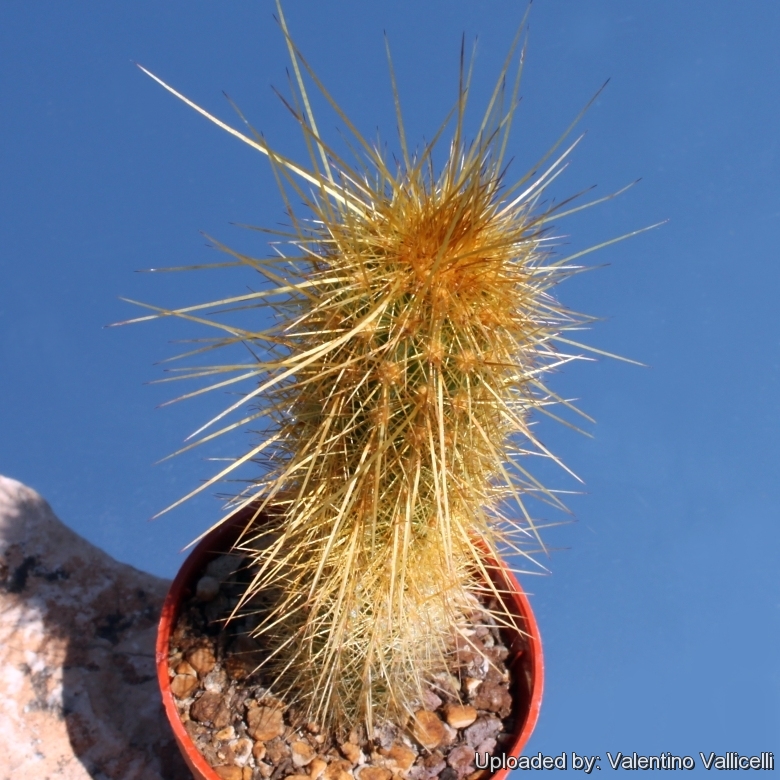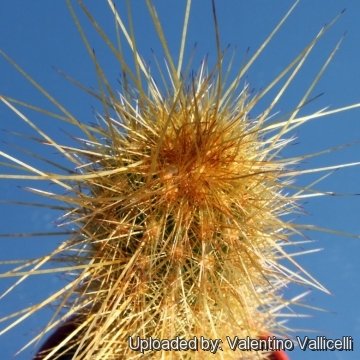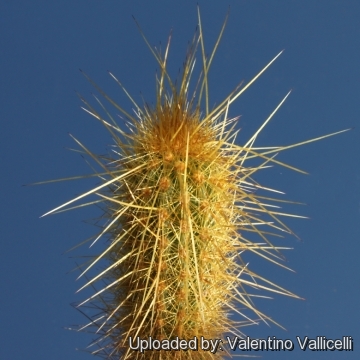




Your support is critical to our success.
Accepted Scientific Name: Bergerocactus emoryi (Engelm.) Britton & Rose
Contr. U.S. Natl. Herb. 12: 474. 1909

Origin and Habitat: Lower and lower Upper Sonoran Zones; from the vicinity of San Diego and Santa Catalina Island, California, southward a few miles beyond Rosario, Lower California. USA.
Altitude: from sea level to 300(-500) metres.
Habitat: It grows on mostly sandy soils of the coastal chaparral and hillsides never nicer than a few miles from the sea, and some of the Channel Islands along with Rosa minutifolia, Aesculus parry, Echinocereus ferrerianus, Mammillaria dioicaSN|916]]SN|916]], Opuntia prolifera, Opuntia chollaSN|10979]], Opuntia chollaSN|10979]], Opuntia oricola and several others. Throughout its range, rain falls mainly in winter, and temperatures are moderated by maritime air. In habitat often fires burn Bergerocactus emoryiSN|5475]]SN|5475]] stands, but afterwards new stems sprout from the tuberous roots. Its habitat is threatened from urban development.
Synonyms:
- Bergerocactus emoryi (Engelm.) Britton & Rose
- Bergerocereus emoryi (Engelm.) Britton & Rose
- Cereus emoryi Engelm.
- Echinocereus emoryi Rümpler
ENGLISH: Golden Cereus, Golden Spine Cereus, Prohibition Cactus, Sprawling Cactus, Velvet Cactus, Snake cactus
CATALAN (Català): Ciri d'or, Cactus d'or de la serp, Ciri d'espina dorsal
SPANISH (Español): Cuiñado, Cirio de oro
SWEDISH (Svenska): Guldtaggskaktus
Description: Bergerocactus emoryiSN|5475]]SN|5475]] is a golden spined shrubby cactus, much branched near ground level, that often forms large thicket of stems to several meters in diameter.
Stems (Branches): Cylindrical, frail, 0,2-1,5(-2) m long, 2-4(-6) cm in diameter, stout, erect, ascending or procumbent, spreading then rooting on the lower side (eventually producing new plants), entirely clothed with a dense mat of bright yellow spines, turning gray to nearly black in age. At the end of each year's growth, the stems become slightly constricted, forming annual segments. Individual stems live about ten years.
Ribs: (14-)16-18(-25), inconspicuous only 2-3 mm high, somewhat tuberculate.
Roots: Tuberose.
Spines: 10-30(-50), slender-acicular dense, often obscuring the stems, yellow but darkening with age, strongly unequal, the 1-3(-6) central of which stouter, the main one bent backward, 3-7 cm long, others spreading, more or less straight.
Flowers: Diurnal, yellow, 2-6 cm broad when expanded. Pericarpels and floral tubes felted and spiny. Outer perianth-segments obtuse, obovate 5-8 mm long, lemon-yellow, tinged with green, inner segments narrower, oblong, 8-10 mm. long, almost or quite devoid of the greenish tinge.
Blooming season: Spring.
Fruit: Globular, 2-3,5(-6) cm in diameter, flushed with purplish red, densely covered with spines 0,5-1,5 cm long, dry at maturity. When ripe, the fruits extrude a ribbon of pulp and seeds over several days
Seeds: Oblong to obovoid and flattened, black, shining, pitted, about 2,5-3 mm long.
Blooming season: Flowers appear throughout the spring on stems 1-5 years old.
Chromosome number: n = 22
Notes: Two natural intergeneric hybrids have been described X Myrtgerocactus lindsayiSN|25395]]SN|25395]] (Bergerocactus emoryiSN|5475]]SN|5475]] X Myrtillocactus cochalSN|7812]]SN|7812]]) and X Pacherocactus orcuttiiSN|8449]]SN|8449]] ( Bergerocactus emoryiSN|5475]]SN|5475]] X Pachycereus pringleiSN|8572]]SN|8572]]), none of them form self-sustaining populations.
Bibliography: Major references and further lectures
1) Raymond M. Turner, Janice Emily Bowers, Tony L. Burgess “Sonoran Desert Plants: An Ecological Atlas” University of Arizona Press, 2005.
2) Edward Anderson “The Cactus family” Timber Press, Incorporated, 2001
3) James Cullen, Sabina G. Knees, H. Suzanne Cubey "The European Garden Flora Flowering Plants: A Manual for the Identification of Plants Cultivated in Europe, Both Out-of-Doors and Under Glass" Cambridge University Press, 11/Aug/2011
4) David R Hunt; Nigel P Taylor; Graham Charles; International Cactaceae Systematics Group. "The New Cactus Lexicon" dh books, 2006
5) N. L. Britton, J. N. Rose “The Cactaceae. Descriptions and Illustrations of Plants of the Cactus Family” Volume II, The Carnegie Institution of Washington, Washington 1920
6) Le Roy Abrams, Roxana Stinchfield Ferris “An Illustrated Flora of the Pacific States: Geraniaceae to Scrophulariaceae, geraniums to figworts” Stanford University Press, 1923
7) Abrams, L. "Geraniums to Figworts." 3: 866 pp. In L. Abrams (ed.) Ill. Fl. Pacific States. Stanford University Press, Stanford. 1951
8) Bailey, L.H. & E.Z. Bailey. “Hortus Third” i–xiv, 1–1290. MacMillan, New York. 1976.
9) CONABIO “Catálogo taxonómico de especies de México” 1. In Capital Nat. México. CONABIO, Mexico City. 2009
10) Flora of North America Editorial Committee. “Magnoliophyta: Caryophyllidae, part 1”. Fl. N. Amer. 4: i–xxiv, 1–559. e. 2003
11) Hickman, J. C. “The Jepson Manual: Higher Plants of California 1–1400.” University of California Press, Berkeley. 1993.
12) Munz, P. A. “Fl. S. Calif.” 1–1086. University of California Press, Berkeley. 1974.
13) Shreve, F. & I. L. Wiggins. “Veg. Fl. Sonoran Des.” 2 vols. Stanford University Press, Stanford. 1964.

Echinocereus emoryi (Bergerocactus emoryi) Photo by: Valentino Vallicelli

Echinocereus emoryi (Bergerocactus emoryi) Photo by: Valentino Vallicelli

Echinocereus emoryi (Bergerocactus emoryi) Photo by: Valentino Vallicelli
The gallery now contains thousands of pictures, however it is possible to do even more. We are, of course, seeking photos of species not yet shown in the gallery but not only that, we are also looking for better pictures than those already present. Read More...
Cultivation and Propagation: Bergerocactus emoryiSN|5475]]SN|5475]] is of relatively easy culture, and suited to hanging baskets as well as pots.
Soil: Use a loose well drained cactus mix.
Repotting: Since they are relatively rapid growers need plenty of space for their roots, repotting with fresh potting-mix should be done every other year or when the plant has outgrown its pot. However, repotting doesn't necessarily mean they'll need larger containers.
Sun Exposure: Outside full sun, inside needs bright light, and some direct sun. During winter month, put them in a cool luminous place and encourage them to enter winter dormancy by withholding water and fertiliser over the winter as they will etiolate, or become thin, due to lower levels of light.
Watering: They require moderately watering through the growing season. This can be done weekly or more frequently during the summertime, if the weather is sunny enough, but allow to dry fully before watering again. Kept this way, plants will show a healthy growth. Keep rather dry as soon as the temperature starts dropping in October and keep it dry in winter. The plant survives outside without protection in winter (cold hardy to -2° ) but is then somewhat prone to rot, too. They should be preferably kept dry during hot weather (especially if grown in the ground).
Fertilization: Give an occasional high potassium liquid feed during the active growing period.
Hardiness: Winter care presents no problems at temperatures from 5 to 15 degrees centigrade with plenty of light, but frost hardy to -2°C for short periods if very dry. This plant needs a period of cool rest in winter to produce flowers abundantly. Cultivated plants do best where summers are relatively cool.
Pest and diseases: They are generally fairly easy to grow, especially if kept pest-free. They are susceptible to, scale insects and spider mite. Watch carefully for infestations of stem and root mealy bugs, and damage from these may well initiate fungal attack.
Propagation: Easy to propagate from cuttings or seeds. Take cuttings spring or summer, let them dry till the ends callous well. Then replant them in fresh cactus soil that is ever so slightly moist, and keep it that way till they root. Surface sowing is the best; seeds germinate in 14-28 days at 20° C , remembering that seedlings dislike strong light and dry conditions.
| Your Actions | |
|---|---|
| Back to Echinocereus index | |
| Back to Cactaceae index | |
 |
Back to Cacti Encyclopedia index |
Privacy stantement - Terms and conditions - How to cite - About us - Feedback - Donate



